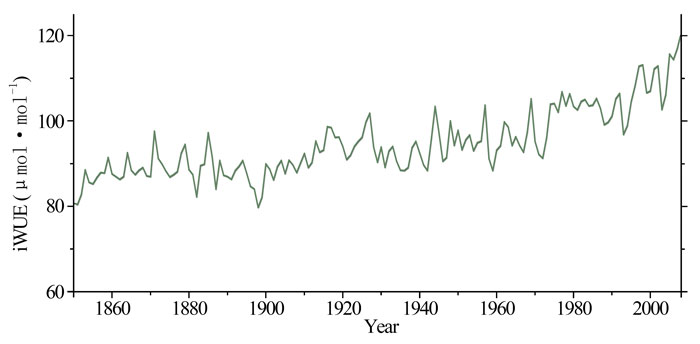| Tweet | Follow @co2science |
Paper Reviewed
Qin, L., Yuan, Y., Shang, H., Yu, S., Liu, W. and Zhang, R. 2020. Impacts of global warming on the radial growth and long-term intrinsic water-use efficiency (iWUE) of Schrenk spruce (Picea schrenkiana Fisch. Et Mey) in the Sayram Lake basin, northwest China. Forests 11: 380, doi:10.3390/f11040380.
Numerous scientific studies have been conducted in both laboratory and field environments to examine the impact of rising atmospheric CO2 on plant water use efficiency (WUE). In nearly all instances those studies reveal rising CO2 improves plant WUE, typically by reducing plant stomatal apertures, which reduces water lost to the air via transpiration. Consequently, at higher levels of CO2, plants tend to need less water to produce the same (or more) amount of tissue, which portends great benefits for the future of agricultural production, especially in arid and irrigated regions.
In recent years, proof of this concept has emerged in studies examining historic trends in the stable carbon isotope ratio (δ13C) of tree rings, which have been utilized to infer long-term changes in intrinsic WUE (iWUE). The latest group of scientists to conduct such a study is that of Qin et al. (2020). Working in northwest China, the six Chinese researchers examined tree-ring cores from Schrenk spruce (Picea schrenkiana) trees growing in the Sayram Lake basin (Xinjiang, China), producing an IWUE record spanning the period 1850 to 2008. The results are presented in Figure 1.
As illustrated there, iWUE increased by approximately 50% over the 160-year period, rising from a value of approximately 80 µmol mol-1 at the beginning of the record to a value of around 120 µmol mol-1 at its end. In comparing the iWUE reconstruction with the air's CO2 content, Qin report finding a high degree of correlation (0.803, n = 50, p < 0.01). This, and other analyses performed in their study led the authors to ultimately conclude "iWUE has increased significantly since the 1850s" in this region and "the main factor affecting iWUE is atmospheric CO2 concentration."
And thus we find yet another real world example that rising atmospheric CO2 is benefitting vegetation across the globe by helping to improve plant iWUE. Since the mid-19th century, the intrinsic water use efficiency of Schrenk spruce trees in the Sayram Lake basin of northwest China have risen by 50%, thanks to a key aerial fertilizer (rising atmospheric CO2) that so many today are wrongfully claiming is an aerial pollutant. How ironic is that?

Figure 1. Historic values of intrinsic water use efficiency (iWUE) derived from cores of Schrenk spruce trees in the Sayram Lake basin, northwest China over the period 1850-2008. Adapted from Qin et al. (2020).




